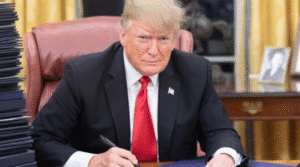Trump’s tariffs: How have they changed America’s relations with its allies and affected its citizens?

;Donald Trump’s negotiating strategy, which he clearly applied in the tariff issue, has many characteristics that can be described as an “all-out pressure attack.” This approach aims to impose certain conditions and force adversaries or allies to the negotiating table. It often relies on exaggerated demands.
Trump typically begins with extreme and unreasonable demands, even if they seem impossible.
The goal is to shock the other party into a defensive position, eventually accepting a solution that appears to be a “compromise” but actually achieves a significant portion of his original goals.
Join us to discuss Trump’s tariffs and how they have impacted international trade and American citizens.
Trump’s Negotiating Strategy
Trump threatens to impose sanctions or harsh measures, such as high tariffs and economic sanctions, or even withdraw from existing agreements, as a means of pressure.
· This creates uncertainty and anxiety in the other party, making them more willing to negotiate to avoid these negative repercussions.
· Trump adopts an approach focused solely on maximizing U.S. gains, without much consideration for the feelings or interests of partners and allies.
· Trump believes that negotiation is not necessarily a “win-win” process, but may require the other party to adhere to his terms.
· Trump is never afraid to escalate tensions or reach the brink of a crisis, believing this increases the pressure on the other party to negotiate.
· Trump does not hesitate to use the media and social media platforms to pressure his opponents, distort their image, and amplify his demands, increasing popular and political pressure on them.
· He never backs down or apologizes, demonstrating a resolute and steadfast stance, regardless of the outcome.

Impact of Tariffs on China
Trump’s tariffs primarily targeted China, aiming to address what the United States considered unfair trade practices, such as intellectual property theft, government subsidies to Chinese companies, and its large trade deficit.
Targeted Goods:
The tariffs covered a wide range of Chinese goods, including solar panels, washing machines, steel, aluminum, and many technological and industrial products.
Impact:
· On China: Despite the pressure, the Chinese economy has demonstrated resilience, as Chinese companies have relocated their exports to other countries and increased domestic consumption and investment. Some Chinese companies have also relocated some of their production to other countries to avoid tariffs.
· On the United States: The tariffs have increased the prices of some imported goods for American consumers and businesses, particularly in the automotive, clothing, and electronics sectors. These tariffs have not significantly reduced the overall US trade deficit, but have instead diverted trade from China to other countries.
Impact of Tariffs on the European Union
Trump sought to impose tariffs on the European Union to pressure it to reduce its tariffs on US goods and address what he considered the “uncompetitiveness” of US products due to government subsidies, value-added taxes, and other factors.
Targeted Goods:
Trump’s threats included tariffs on steel, aluminum, timber, semiconductor chips, and pharmaceutical products, affecting goods worth an estimated €380 billion.
Impact:
On the European Union: Trump’s threats sparked significant concern in European markets, with investment banks warning that they could lead to a permanent and deep economic slowdown in the EU and force the European Central Bank to cut interest rates. The tariffs were expected to cost the Italian agrifood industry alone billions of euros.
The European Union announced countermeasures, such as tariffs on billions of dollars’ worth of US goods.
Impact of Tariffs on Mexico
Trump’s tariffs on Mexico aimed to pressure it to curb illegal immigration to the United States and improve the terms of trade agreements. Targeted Goods:
The tariffs initially included all Mexican imports, then focused specifically on automobiles, household appliances, and coffee.
Impact:
On Mexico: The tariff threats raised significant concerns in Mexico, particularly in the auto sector, which relies heavily on exports to the United States. Mexico was forced to take measures to curb illegal immigration to avoid the tariffs.
On the United States: One expected outcome was a rise in the price of cars imported from Mexico.
Impact of Tariffs on Canada
Trump’s tariffs on Canada were intended to address what he considered “high tariffs” imposed by Canada on certain U.S. products, such as dairy products, steel, and aluminum.
Targeted Goods:
The tariffs focused on steel, aluminum, and dairy products, and Trump threatened to impose tariffs on Canadian cars.
Impact:
On Canada: Canada faces the risk of rising consumer prices and unemployment, which could lead to a recession in the Canadian economy, which is highly dependent on trade with the United States. The Bank of Canada expects Canada’s growth to be permanently stunted by the tariffs, with inflation likely to rise. Canada imposed retaliatory tariffs on US goods in response to Trump’s tariffs.
How have Trump’s tariffs affected the average American?
The average American has been affected by Trump’s tariffs in several ways, most notably:
Increased prices:
Taxes have increased the cost of imported goods, which has been reflected in retail prices for consumers. It is estimated that the tariffs could add hundreds of dollars in additional annual costs to each American. Sectors such as automobiles, clothing, electronics, and building materials have been affected, with prices immediately rising.
Inflationary pressures:
Taxes have contributed to increased inflationary pressures in the US economy, as consumers anticipate higher inflation due to the scarcity of goods.
Impact on US businesses
US businesses that rely on imported spare parts or certain components, raw materials, and other manufacturing supplies have also been affected in the following ways:
Increased costs:
US businesses that import tariff-bound goods or components have incurred additional costs, impacting their profit margins and competitiveness.
Supply chain disruption:
The trade war has disrupted global supply chains, making it difficult for US businesses to source certain raw materials or finished products.
Shipments from China Declined:
Shipments from China declined sharply due to tariffs, prompting US importers to tap into excess inventories or seek alternative suppliers.
Stock Market Losses:
Shares of some US companies fell due to concerns about the impact of tariffs and the trade war.
Labor Market Impact:
The trade war raised concerns about the threat to the US labor market and the increasing difficulty of finding jobs in critical sectors, which could pressure wages and benefits for American workers.
Economic Uncertainty:
Trump’s trade policies have created uncertainty and rapid volatility in the US and global economy, impacting investment and spending decisions.
While these tariffs were intended to boost domestic industries and reduce the trade deficit, their impact on ordinary citizens has been higher living costs and increased economic pressure.
Also Read:
- a-chinese-humanoid-robot-cooks-using-virtual-reality
- brain-computer-interfaces-when-telepathy-becomes-a-technological-reality
- will-tiktok-go-bankrupt-after-the-new-us-decisions




